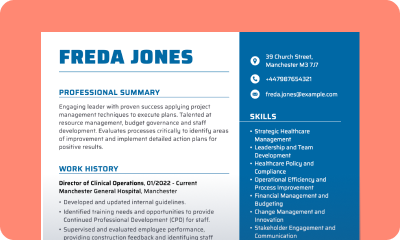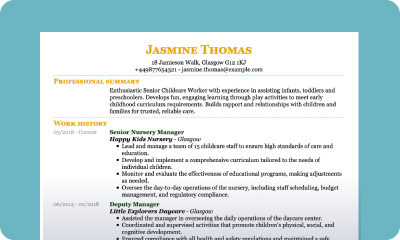- Our customers have been hired by : *Foot Note
What is a school leaver CV?
A school leaver CV is a short, professional document that highlights your education, skills, and achievements when you’re applying for your first job after finishing school. It’s designed to show employers your potential — even if you have no work experience yet.
A great CV for school leavers with no work experience focuses on your transferable skills, extracurricular activities, and academic achievements. With the right school leaver CV template and examples, you can present yourself as motivated, capable, and ready to start your career.
In this guide, we’ll show you how to create a school leaver CV that gets noticed.
Here’s what you’ll find:
- School leaver CV examples
- CV templates for school leavers
- Step-by-step guide on writing a school leaver CV with no experience
- Expert tips and dos & don’ts for your first CV
- Answers to common school leaver CV questions
SEARCH ALL CV EXAMPLES
CV for school leaver example
Dylan Cooke
07912 345 678
dyaln.cooke@example.co.uk
PROFESSIONAL SUMMARY
Motivated and reliable school leaver with strong communication, teamwork, and problem-solving skills. Recently completed GCSEs with a focus on English, Maths, and Computer Science. Keen to start a career in an office or retail environment where I can develop my skills, gain experience, and contribute to a positive team. I’m eager to learn quickly, take on new challenges, and grow within a company that values hard work and enthusiasm.
WORK HISTORY
March 2024 – current
Tesco Express – Birmingham
Customer Assistant (Part-time)
- Supported customers at checkouts and handled cash accurately
- Re-stocked shelves and maintained store presentation
- Helped new staff learn store processes
- Gained confidence in problem-solving and working in a team
- Improved customer relations by addressing queries and concerns.
EDUCATION
June 2025
St. Mary’s Secondary School Birminham
GCSEs
English Language – 8
English Literature – 7
Mathematics – 7
Computer Science – 8
Business Studies – 7
Geography – 6
SKILLS
- Excellent communication and teamwork
- Reliable and organised under pressure
- Confident with Microsoft Office and Google Workspace
- Strong numeracy and analytical thinking
- Friendly customer service and positive attitude
- Fast learner with attention to detail
Hobbies and interest
- Coding small websites and digital designs
- Playing football and participating in local youth leagues
- Reading about technology and digital innovation
The best format for a school leaver CV
The right CV format helps you present your skills and education in the best way possible. As a school leaver, your focus isn’t on long work history but on showing your potential, attitude, and what you’ve learned so far. A well-structured CV makes it easy for employers to see your strengths and understand what you could bring to their team.
The two most common and useful CV formats are the skills-based CV and the reverse-chronological CV.
Skills-based CV format
A skills-based CV focuses on what you can do, not just where you’ve worked. It groups your abilities into sections such as communication, teamwork, organisation, or digital skills. This format is perfect for school leavers who want to highlight strengths gained through school projects, volunteering, or part-time work.
Use this format if you want to:
- Emphasise your transferable skills rather than job titles
- Highlight achievements from school, clubs, or volunteering
- Apply for your first job or apprenticeship with limited experience
It’s a great choice if you’ve not had full-time work yet but want to show you’re ready to contribute from day one.
Reverse-chronological CV format
The reverse-chronological CV lists your most recent education or experience first, followed by older entries. It’s the most familiar format for employers and works well if you’ve had part-time jobs, work experience, or an apprenticeship.
Don’t worry if your experience section feels short — recruiters understand that most school leavers won’t have a long work history. Even short placements, volunteering, or after-school jobs show responsibility, teamwork, and initiative.
Use this format if you want to:
- Show recent experience, even if it’s part-time or temporary
- Present your education and achievements in a clear timeline
- Highlight steady progress and growing responsibility
School leaver CV tips
- Keep it to one page: Try to fill a single page by including all the key details. Focus on what’s most relevant to the job or apprenticeship you’re applying for.
- Use clear headings: Include sections for contact details, profile, skills, experience, and education. You can also add optional sections like hobbies or interests if you need to fill extra space.
- Choose a simple font: Use easy-to-read styles such as Calibri, Arial, or Helvetica. Avoid fancy or decorative fonts.
- Don’t add a photo: Photos aren’t needed on CVs in the UK and can distract from your information.
How to write a school leaver CV step by step
Writing a great CV is about more than just listing your subjects or part-time jobs. It should show your skills, education, and enthusiasm in a clear and organised way.
Your CV should include key sections such as your contact details, CV summary, skills, experience, and education. You can also add optional sections like hobbies or certificates to help fill a whole page.
Here are the key steps we’ll cover:
- How to write a school leaver CV summary
- How to highlight your skills effectively
- How to structure your experience section
- How to list your education and qualifications
- How to include optional sections to complete your CV
Step 1: Add your contact details
Start your CV with your contact details at the very top so employers can easily get in touch. Keep this section short, tidy, and professional.
Here’s what to include:
- Full name – write your first and last name.
- Location – include your town or city (no need for a full address).
- Phone number – use a personal mobile number
- Email address – choose a simple, professional one (for example, firstname.lastname@email.com).
- Optional links – if you have one, you can add your LinkedIn profile or an online portfolio.
Example contact section
Emma Taylor
Birmingham
07432 678 901
emma.taylor@email.com
Step 2: Write your school leaver CV summary
Your CV summary (also called a personal statement) appears just below your contact details. It’s a short paragraph that introduces who you are, what you’re good at, and what you’re aiming for.
For school leavers, this section should focus on your strengths, interests, and enthusiasm rather than work history. Think about what makes you a good fit for the job or apprenticeship — your attitude, skills, and what you’ve achieved at school or in part-time roles.
Here’s what to include:
- Who you are – e.g. “Friendly and reliable individual with strong communication and teamwork skills.”
- Key strengths – e.g. “Confident using Microsoft Office and handling customer service tasks.”
- Goal or focus – e.g. “Looking for an apprenticeship in business administration to build professional experience.”
Tip: Tailor your personal statement to each role. Read the job advert and use similar keywords to show you’re a good match.
CV personal statement example for school leavers
“Enthusiastic and reliable individual with excellent communication and teamwork skills. Recently completed A-Levels in Business, IT, and English Language, and now looking to start a career in office administration. Eager to learn new skills and contribute to a friendly, professional team.”
Step 3: Add your work experience
Your experience section is where you show how you’ve developed useful skills through real-life activities. This could include part-time jobs, volunteering, work experience placements, or school projects. Recruiters understand that most school leavers won’t have a long work history — they’re looking for signs of responsibility, teamwork, and a positive attitude.
If you haven’t had a job yet, don’t worry. You can include volunteering, community work, or school responsibilities such as helping at events, mentoring younger students, or organising fundraisers. These experiences all show valuable qualities employers appreciate.
For each entry, include:
- Role or activity name
- Organisation or place
- Dates (month and year)
- A few bullet points describing what you did and what you learned
When writing your bullet points, start with action words like helped, organised, supported, or assisted. Keep them short and focused on your contribution.
Example of experience section
Customer Assistant
Tesco Express, Birmingham
March 2024 – September 2024
- Helped customers at checkouts and handled payments accurately
- Restocked shelves and kept displays tidy
- Worked as part of a friendly team during busy shifts
- Learned how to manage time and provide good customer service
Step 4: Highlight your key skills
Your skills section is one of the most important parts of your CV — especially if you don’t have much work experience yet. It shows employers what you’re good at and what you can bring to their team.
Include a mix of soft skills (how you work with others) and practical skills (what you can do). Keep the list short and relevant to the job or apprenticeship you’re applying for.
Here are some examples you could include:
- Communication and teamwork
- Organisation and time management
- Customer service
- Problem-solving
- Basic IT skills (Microsoft Office, Google Workspace)
- Attention to detail
- Willingness to learn
- Reliability and punctuality
Tip: Check the job advert — if certain skills are mentioned (like teamwork or communication), try to include them in your list so your CV feels tailored to that role.
Step 5: List your education and certificates
Your education CV section shows employers what you’ve studied, what qualifications you’ve earned, and any subjects that relate to the job or apprenticeship you’re applying for.
List your qualifications in reverse order, starting with your most recent studies. You can also include predicted grades if you haven’t received your results yet.
If you’ve completed any extra courses or certificates — such as First Aid, Food Hygiene, or online training — include them too. They show that you’re proactive and eager to learn new things.
Here’s what to include:
- School or college name
- Qualification type (GCSEs, A-Levels, or equivalent)
- Subjects and grades (or predicted grades)
- Dates attended or year completed
- Any short courses or certificates
Example of an education section
Central Sixth Form College, Manchester
A-Levels, Completed June 2025
- Business Studies – B
- IT – B
- English Language – C
St. Andrew’s High School, Manchester
GCSEs, Completed June 2023
Step 6: Add optional CV sections
If your CV feels a bit short, you can add one or two optional sections to help fill the page and show more of your personality. These sections can also highlight useful skills or qualities that don’t appear elsewhere on your CV.
Here are some examples you could include:
- Hobbies and interests – Choose ones that show teamwork, creativity, or commitment (e.g. playing football, volunteering, gaming, or music).
- Projects – Include any school, personal, or online projects that helped you build skills relevant to the role.
- Positions of responsibility – Mention things like being a prefect, class representative, or team captain.
- Volunteering – Add any unpaid roles that show initiative and community involvement.
Tip: You can streamline your writing process by using our CV maker app, which guides you through each section step by step.
Dos and don’ts for a school leaver CV
Adapt your personal statement to match what the employer is looking for. Focus on your most relevant skills, interests, or achievements — whether that’s teamwork, customer service, organisation, or problem-solving.
Even if you don’t have lots of work experience, you can still show what makes you a great candidate. Use examples from school projects, volunteering, or part-time work to prove you’re responsible and eager to learn.
You don’t need to state that you’re a “school leaver” in your CV — employers can see that from your education and experience. Instead, focus on what you can offer and how ready you are to start your career.
If you’ve chosen to start work instead of going to university, be ready to explain your decision clearly and confidently. Talk about your goals, what you hope to learn in the workplace, and how gaining real experience fits with your long-term plans. To help you get ready, check out our common interview questions and answers guide.
Your school leaver CV questions answered
What kinds of school-leaver jobs can I apply for?
There are many great school leaver jobs across different industries, from retail and hospitality to administration, customer service, and IT. You can also look for apprenticeships in areas like engineering, finance, or healthcare.
When searching online, try using keywords such as “entry-level jobs,” “no experience jobs,” “apprenticeships,” “trainee roles,” or “junior positions.” These phrases often bring up opportunities suited to school leavers. You can also search for “school leaver programmes” offered by larger companies, which combine training with hands-on experience.
How long should a school leaver CV be?
Aim for one page. Since you’re just starting your career, keep your CV short, clear, and focused on your education, skills, and any experience you have — including volunteering or part-time work.
What should I include if I have no work experience?
That’s completely normal. You can include school projects, volunteering, extracurricular activities, or positions of responsibility (like prefect or team captain). These all show transferable skills such as teamwork, organisation, and leadership.
Can I use the same CV for every job?
It’s better to adjust your CV for each role. Tailor your personal statement and skills to match what’s in the job description. This shows employers you’ve put thought into your application.
Do I need a cover letter with my school leaver CV?
It’s a good idea, even if it’s not required. A short, tailored cover letter helps you explain why you’re interested in the job and what makes you a good fit.
Related Student CV Examples & Templates
Create your school leaver CV today
Start your career journey with confidence. Create a professional school leaver CV that showcases your skills, education, and potential, even if you have limited or no work experience. Use our expert tips and easy-to-use CV templates to create a job-ready CV in minutes.
*The names and logos of the companies referred to above are all trademarks of their respective holders. Unless specifically stated otherwise, such references are not intended to imply any affiliation or association with myperfectCV.




